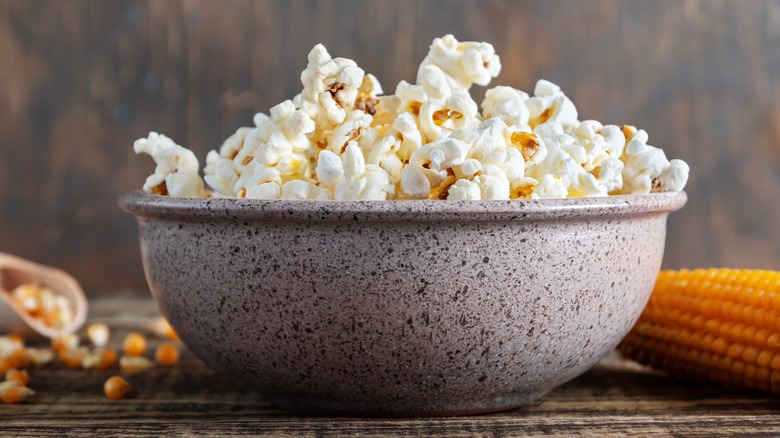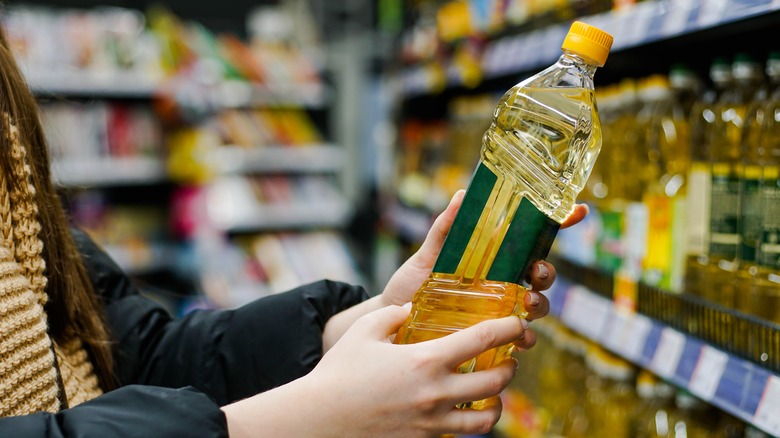The Oil Mistake That's Keeping You From Perfect Popcorn
With modern technology, it's easier than ever to have a real movie theater experience at home while lounging on the sofa. However, there is one part of the movie-going adventure that many people struggle replicating at home: the popcorn. Even when you go for the air-popped option (versus microwave) and follow the directions on the jar of kernels, it might seem like there is still a little something missing in the taste of the snack.
The trick to enhancing the flavor of stovetop popcorn is actually increasing the amount of oil called for in the instructions. Orville Redenbacher Original Kernels label, for example, suggests using 1 tablespoon oil for every 3 tablespoons of kernels, but doubling or even tripling the amount of suggested oil will lead to a crunchier and far more satisfying batch.
That's because oil serves an important purpose in the cooking process. A layer of oil in the bottom of a pot will heat it all uniformly, creating a controlled environment for the kernels to pop. A pot that doesn't have enough oil will have an uneven distribution of heat, causing some pieces to burn while other kernels are still waiting to pop. Oil also slightly decreases the cooking time, thanks in large part to its heating capabilities.
When it comes to making perfect popcorn, the amount of oil is not the only consideration to make; the type is also important.
The type of oil can affect popcorn's taste
There are so many cooking oils to try, it may be hard to know which one to choose to make the perfect batch of popcorn. First, it's necessary to understand something about oil's smoke point, or the temperature at which the oil starts to burn. It can be as low as 225 degrees Fahrenheit for something like an unrefined flaxseed oil and generally tops out at around 500 degrees Fahrenheit with a refined avocado oil. The ideal temperature for popping kernels is between 400-460 degrees Fahrenheit. This range narrows down the oil choices to those which have a smoke point that can withstand that temperature — because, if the oil used hits its smoke point before the popping is complete, the burning oil can infuse popcorn with a bitter taste.
The second consideration when it comes to the best oil choice is flavor. Some, like extra virgin olive oil or sesame oil, have a very distinct flavor that will influence the taste of your popcorn. That's not necessarily a bad thing for fans of those flavors, but for those who want a crunchy, corn-forward taste, a neutral-flavored oil would be best. Some options include canola oil, peanut oil, and grapeseed oil.
All these tips undoubtedly will create better-tasting homemade popcorn. But if you want to replicate movie theater popcorn as close as you can, there are some invaluable trade secrets.
More movie theater popcorn secrets
Movie theaters across the country use three main ingredients when making popcorn. First, the industry standard choice is coconut oil, specifically a butter-flavored version that looks like liquid gold. The oil doesn't contain any actual butter but does have artificial butter flavoring. This type of coconut oil is widely available online if you want to try it at home.
The second special ingredient is a product called Flavacol. This flavor-enhanced salt, when added to the coconut oil, perfectly sticks to the popcorn and also provides that trademark yellow color that entices movie-goers to buy a bucket. A little goes a long way; just a 1/2-cup of kernels only needs 1/2 teaspoon of Flavacol.
The final ingredient is optional but most refuse to pass it up. The "butter" that is drizzled on top of popcorn is actually a soybean oil that is artificially flavored to taste like butter. When combined with coconut oil and Flavacol, you have the perfect batch of movie munchies. Trying it at home will make your popcorn indistinguishable from what you get at the theater.



